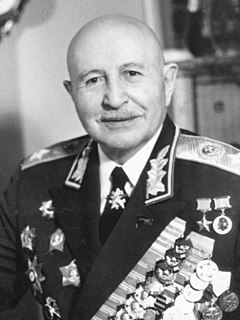 W
WIvan Khristoforovich Bagramyan, also known as Hovhannes Khachaturi Baghramyan, was a Soviet military commander and Marshal of the Soviet Union of Armenian origin. During World War II, Bagramyan was the second non-Slavic military officer, after Latvian Max Reyter, to become a commander of a Front. He was among several Armenians in the Soviet Army who held the highest proportion of high-ranking officers in the Soviet military during the war.
 W
WGleb Vladimirovich Baklanov was a Soviet Army colonel general and a Hero of the Soviet Union.
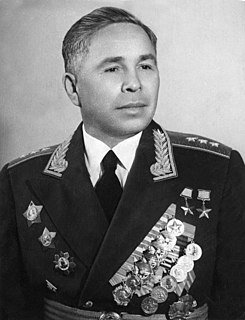 W
WAfanasy Pavlantyevich Beloborodov was general in the Red Army during the Second World War who was twice awarded the title Hero of the Soviet Union. Between 1963 and 1968, he commanded the Moscow Military District.
 W
WTalgat Jakypbekuly Bigeldinov was a ground-attack pilot during the Second World War and the only Kazakh who was twice awarded the title Hero of the Soviet Union. He remained in the military after the war and reached the rank of lieutenant colonel before he transferred to the reserve. After Kazakhstan became independent from the Soviet Union he was promoted to the rank of Major-General.
 W
WLeonid Ilyich Brezhnev was a Soviet politician who led the Soviet Union as General Secretary of the governing Communist Party (1964–1982) and as Chairman of the Presidium of the Supreme Soviet (1977–1982). His 18-year term as general secretary was second only to Joseph Stalin's in duration. While Brezhnev's rule was characterised by political stability and notable foreign policy successes, it was also marked by corruption, inefficiency, economic stagnation, and rapidly growing technological gaps with the West.
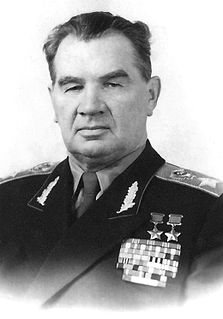 W
WVasily Ivanovich Chuikov was a Soviet military commander and Marshal of the Soviet Union. He is best known for commanding the 62nd Army which saw heavy combat during the Battle of Stalingrad in the Second World War.
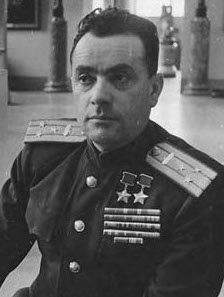 W
WDavid Abramovich Dragunsky was a tank officer in World War II who was twice awarded the title Hero of the Soviet Union.
 W
WIvan Ivanovich Fedyuninsky was a Soviet military leader and Hero of the Soviet Union (1939).
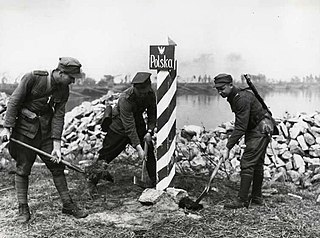 W
WThe Polish First Army was an army unit of the Polish Armed Forces in the East. It was formed in the Soviet Union in 1944, from the previously existing Polish I Corps in the Soviet Union, as part of the People's Army of Poland (LWP). The First Army fought westward, subordinated to the Soviet 1st Belorussian Front, during the offensive against Nazi Germany that led to the capture of Warsaw in January 1945, and the capture of Berlin in May 1945.
 W
WMusa Gaysinovich Gareyev was a squadron commander in the 76th Guards Ground Attack Aviation Regiment of the Soviet Air Forces during the Second World War. He was also the only Bashkir twice awarded the title Hero of the Soviet Union.
 W
WLeonid Aleksandrovich Govorov was a Soviet military commander. Trained as an artillery officer, he joined the Red Army in 1920. He graduated from several Soviet military academies, including the Military Academy of Red Army General Staff. He participated in the Winter War of 1939–1940 against Finland as a senior artillery officer.
 W
WIvan Stepanovich Konev was a Soviet general and Marshal of the Soviet Union who led Red Army forces on the Eastern Front during World War II, responsible for taking much of Axis-occupied Eastern Europe.
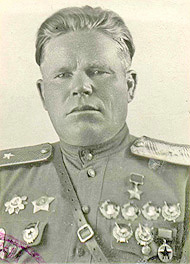 W
WIvan Nikitich Konev was a Soviet major general during World War II and a Hero of the Soviet Union. Konev led the 3rd Guards Airborne Division through most of the war and was awarded the title Hero of the Soviet Union for his leadership of the division during the Second Jassy–Kishinev Offensive. Postwar, Konev continued to serve in the Soviet Army and became the deputy commander of multiple army corps.
 W
WVladislav Vikentyevich Korchits was a Soviet and Polish general. He supported the Bolshevik side during the Russian Revolution, joining the Red Army. He participated in the Polish-Soviet War. In the interwar period he graduated from the Mikhail Frunze Military Academy. He was imprisoned and tortured during the Great Purge, survived it and was reinstated afterward. He took part in World War II. From 1944 he was attached to the Polish Armed Forces in the East. After the war he remained in the People's Republic of Poland. He served in the Polish People's Army as the chief of Polish General Staff from 1 January 1945 to 18 January 1954. While in Poland, he joined the Polish Workers' Party, was the Deputy Minister of National Defense (1949/1950-?), and the deputy to the Polish parliament (Sejm) for the term 1952-1956. In 1954 he retired and returned to the Soviet Union. He died in Moscow.
 W
WPyotr Kirillovich Koshevoy was a Soviet military commander and a Marshal of the Soviet Union.
 W
WNestor Dmitryevich Kozin was a Soviet Army major general. After being drafted into the Red Army in 1924, Kozin became an officer and from 1939 was a battalion commander in the 107th Rifle Division. Kozin fought in the Yelnya Offensive after the 107th was moved west and became a regimental commander in the 100th Rifle Division in August 1941. After the end of the Yelnya Offensive in early September, Kozin was awarded the Order of Lenin for his leadership and the 100th Rifle Division became the 1st Guards Rifle Division. He then fought in the Battle of Moscow and in April 1942 was appointed commander of the 8th Motor Rifle Division NKVD. The division became the 63rd Rifle Division in June and fought in Operation Uranus. Kozin received the Order of Suvorov 2nd class and the division became the 52nd Guards Rifle Division for its actions in the offensive. The division continued to fight at Stalingrad and Kozin was wounded in January 1943. After recovery, he was sent to study at the Military Academy of the General Staff, where he remained until given command of the 13th Guards Airborne Division in April 1944. During August and September, Kozin led the 189th Rifle Division during the Tartu Offensive. In September, he returned to command of the 52nd Guards Rifle Division and led it during the Baltic Offensive, Vistula–Oder Offensive, East Pomeranian Offensive and Berlin Offensive. For his leadership of the division, Kozin was awarded the title Hero of the Soviet Union on 29 May. After the war, he continued to serve in the army and retired in 1954. He lived in Barnaul and died in 1992.
 W
WYevgeny Maksimovich Kungurtsev was a squadron commander in the 15th Guards Ground Attack Aviation Regiment during the Second World War who was twice awarded the title Hero of the Soviet Union. He went on to become a Major-General of Aviation in 1964.
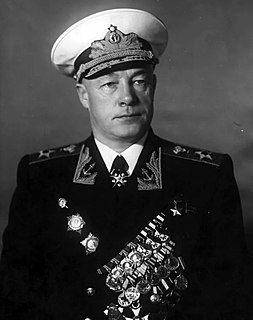 W
WNikolay Gerasimovich Kuznetsov was a Soviet naval officer who achieved the rank of Admiral of the Fleet of the Soviet Union and served as People's Commissar of the Navy during the Second World War. The N. G. Kuznetsov Naval Academy and the Russian aircraft carrier Admiral Kuznetsov are named in his honor.
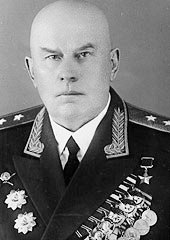 W
WAnton Ivanovich Lopatin was a Soviet officer during the Second World War, and Hero of the Soviet Union.
 W
WRodion Yakovlevich Malinovsky was a Soviet military commander in World War II, Marshal of the Soviet Union, and Minister of Defence of the Soviet Union in the late 1950s and 1960s. He contributed to the major defeat of Nazi Germany at the Battle of Stalingrad and the Battle of Budapest. During the post-war era, he made a pivotal contribution to the strengthening of the Soviet Union as a military superpower.
 W
WKirill Afanasievich Meretskov was a Soviet military commander. Having joined the Communist Party in 1917, he served in the Red Army from 1920. During the Winter War of 1939-1940 against Finland, he had the task of penetrating the Mannerheim Line as commander of the 7th Army. He was awarded the title of Hero of the Soviet Union shortly afterwards.
 W
WAlexander Ivanovich Pokryshkin was one of the highest-scoring Soviet aces, and earned the title Hero of the Soviet Union three times: 24 May 1943, 24 August 1943, and 19 August 1944. After the war he reached the rank of Marshal of Aviation.
 W
WKonstantin Konstantinovich (Xaverevich) Rokossovsky was a Soviet and Polish officer who became Marshal of the Soviet Union, Marshal of Poland, and served as Poland's Defence Minister from 1949 until his removal in 1956 during the Polish October. He was among the most prominent Red Army commanders of World War II.
 W
WMatvey Kuzmich Shaposhnikov was a Soviet military commander, Lieutenant General and Hero of the Soviet Union. During the Novocherkassk massacre in 1962, as the first deputy commander of the North Caucasian Military District, he refused to comply with the order to attack the demonstrators with tanks.
 W
WVasily Danilovich Sokolovsky was a Soviet general and Marshal of the Soviet Union who led Red Army forces on the Eastern Front during World War II. As Georgy Zhukov's chief of staff, Sokolovsky helped plan and execute the Capture of Berlin.
 W
WVladimir Dimitrov Stoychev was a Bulgarian Colonel General, diplomat and Olympic equestrian.
 W
WKarp Vasilyevich Sviridov was a Soviet Army lieutenant general and a Hero of the Soviet Union.
 W
WKarol Wacław Świerczewski was a Pole serving as a Red Army general. He was a Bolshevik party member and Soviet officer in the wars fought abroad by the Soviet Union including the one against Polish as well as Ukrainian Republics and in Republican Spain. In 1939 he participated in the Soviet invasion of Poland again. At the end of World War II in Europe he was installed as one of leaders of the Soviet-sponsored Polish Provisional Government of National Unity. Soon later, Świerczewski died in a country-road ambush shot by the militants from OUN-UPA. He was an icon of communist propaganda for the following several decades.
 W
WMajor General Semyon Alexanderovich Tchernetsky was a Soviet military conductor and the founder of modern Russian military bands. He served as the Senior Director of the Central Military Band of the People's Commissariat of National Defense of the USSR from 1924 to 1950.
 W
WFedor Ivanovich Tolbukhin was a Soviet military commander and Marshal of the Soviet Union.
 W
WAleksandr Mikhaylovich Vasilevsky, was a Russian career-officer in the Red Army, attained the rank of Marshal of the Soviet Union in 1943. He served as the Chief of the General Staff of the Soviet Armed Forces (1942-1945) and Deputy Minister of Defense during World War II, and as Minister of Defense from 1949 to 1953. As the Chief of the General Staff from 1942 to 1945, Vasilevsky became involved in planning and coordinating almost all the decisive Soviet offensives in World War II, from the Stalingrad counteroffensive of November 1942 to the assaults on East Prussia, Königsberg and Manchuria.
 W
WVasily Sergeyevich Yefremov was a squadron commander in the 10th Guards Bomber Aviation Regiment of the Soviet Air Force during World War II who was twice awarded the title Hero of the Soviet Union.
 W
WAndrey (Andrei) Ivanovich Yeryomenko was a Soviet general during World War II and, subsequently, a Marshal of the Soviet Union. During the war, Yeryomenko commanded the Southeastern Front during the Battle of Stalingrad in summer 1942 and planned the successful defense of the city. He later commanded the armies responsible for the liberation of Western Hungary and Czechslovakia in 1945.
 W
WGeorgy Konstantinovich Zhukov was a Soviet general and Marshal of the Soviet Union. He also served as Chief of the General Staff, Minister of Defence, and was a member of the Presidium of the Communist Party. During the Second World War, Zhukov oversaw some of the Red Army's most decisive victories.